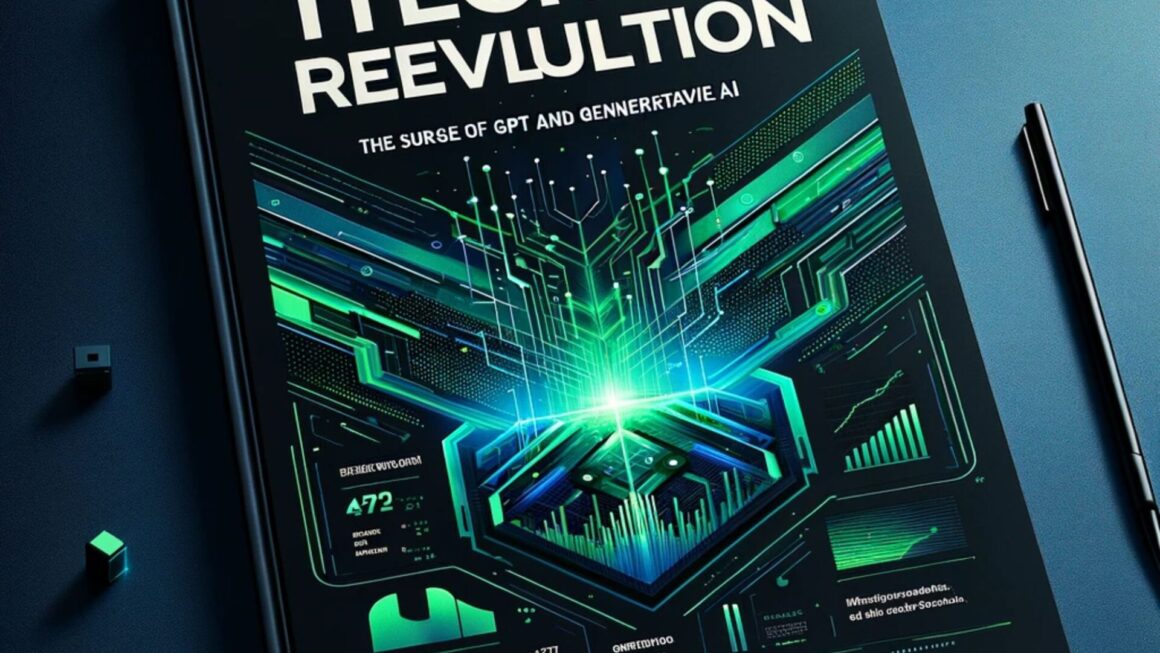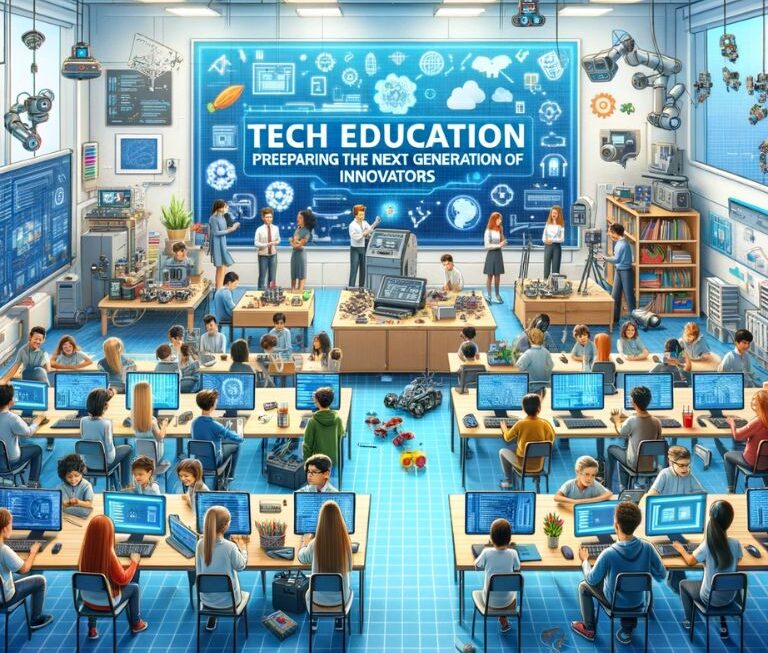As we embark on 2023, the landscape of global technology is not just evolving—it’s undergoing a revolution. This year marks a significant milestone in the journey of computer innovations, with groundbreaking advancements that are reshaping industries, economies, and our everyday lives. From the ever-expanding capabilities of artificial intelligence to groundbreaking developments in quantum computing, we stand at the precipice of a digital era unlike any we’ve experienced before.
The Accelerated Pace of Change
In the past decade, the pace of technological advancement has accelerated exponentially. The convergence of various technologies has led to the emergence of new paradigms in computing and digital interaction. This year, several key areas have seen significant breakthroughs, setting the stage for a future that once seemed confined to the realms of science fiction.
Artificial Intelligence: From Concept to Reality
Artificial intelligence (AI) has transitioned from theoretical research to a practical, impactful technology. Beyond the realms of data analysis and pattern recognition, AI is now a creative force. Software models developed by giants like Google and OpenAI are transforming industries with their ability to generate artworks, designs, and solutions based on minimal input, heralding a new age of AI-assisted creativity.
Quantum Computing: The Next Quantum Leap
Quantum computing, once a speculative field, is making tangible strides. Companies like IBM have extended their Quantum Development Roadmaps, promising advanced hardware and new possibilities in computation. These quantum systems, with their capability to process complex data at unprecedented speeds, are not just a technological advancement; they represent a fundamental shift in our problem-solving capabilities.
The Global Impact
The implications of these innovations extend far beyond the confines of technology sectors. They have the potential to address global challenges, from climate change to healthcare, and to drive economic growth in emerging industries. The integration of these technologies into everyday life is not just imminent; it’s already underway.
The Rise of AI Artistry
2023 marks a significant year in the evolution of artificial intelligence (AI) as a creative force. This section delves into how AI, particularly in the realm of image generation and digital art, has transcended its traditional boundaries, fostering a new era of digital creativity.
AI’s Leap into the Creative Realm
The transformation of AI from a tool for data processing to a creator of art has been nothing short of revolutionary. Leveraging advanced algorithms and deep learning techniques, AI systems developed by leading tech companies such as Google and OpenAI are now capable of generating stunning visual artworks based on textual descriptions. This remarkable ability signifies a paradigm shift in the creative process, where AI collaborates with human imagination to bring abstract concepts to life.
The Mechanism Behind AI-Generated Art
AI-generated art is a product of complex machine learning models, particularly Generative Adversarial Networks (GANs) and Variational Autoencoders (VAEs). These models are trained on vast datasets of images and texts, allowing them to understand and replicate artistic styles and elements. When provided with a text prompt, the AI interprets and renders it into a visual representation, often with astonishing creativity and attention to detail.
Impact on the Art and Design Industry
The advent of AI in art and design is transforming these industries in several ways:
- Enhanced Creativity: AI is enabling artists and designers to explore new realms of creativity, pushing the boundaries of traditional art forms.
- Accessibility: AI art tools are democratizing the creation of art, making it accessible to individuals without formal artistic training.
- Efficiency: In sectors like advertising and media, AI-generated images can significantly reduce the time and cost involved in producing visual content.
Ethical and Intellectual Property Considerations
As AI continues to make inroads into creative fields, it raises important ethical and intellectual property questions. Issues such as the originality of AI-generated art, copyright, and the rights of the data used in training these models are hotly debated topics in the art and technology communities.
Revolution in Chip Design: The RISC-V Impact

In 2023, the computer hardware industry is witnessing a seismic shift with the emergence of RISC-V, an open standard for chip design. This development is not just a technical achievement; it represents a significant change in the power dynamics of the semiconductor industry.
Understanding RISC-V
RISC-V (Reduced Instruction Set Computing – V) is an open-source instruction set architecture (ISA). Unlike proprietary ISAs owned by companies like Intel and ARM, RISC-V is freely available for anyone to use and modify. This openness has significant implications:
- Lower Costs: Without licensing fees, the cost of chip development is reduced, making it more accessible to startups and smaller companies.
- Customization: Companies can customize RISC-V to meet specific needs without the constraints of proprietary designs.
- Community-driven Innovation: An open standard fosters a community of developers contributing to and improving the architecture.
Impact on the Chip Industry
The adoption of RISC-V is reshaping the chip industry in several ways:
- Increased Competition: The entry of new players is challenging the dominance of established firms and fostering innovation.
- Diversification of Designs: RISC-V allows for a wider range of chip designs tailored to specific applications, from IoT devices to supercomputers.
- Global Collaboration: As an open standard, RISC-V is promoting global collaboration, with contributions from researchers and developers worldwide.
The Era of Affordable Military Drones
The year 2023 has seen a pivotal shift in the realm of military technology, particularly in the accessibility and capabilities of military drones. This shift is largely attributed to advances in consumer componentry and communications technology, drastically reducing costs and expanding availability.
A Change in Warfare Dynamics
Traditionally, military drones were exclusive to wealthier nations due to their high costs and strict export controls. However, technological advancements have enabled the production of sophisticated drones at significantly lower prices, altering the dynamics of modern warfare.
Key Factors Driving Drone Accessibility
- Advanced Consumer Technology: The integration of high-quality consumer-grade components into drone manufacturing has reduced costs without compromising on capability.
- Improved Communication Systems: Advances in communication technologies have enhanced the control and range of drones, making them more versatile and effective.
- Global Market Expansion: The expansion of the global drone market has led to increased competition and innovation, further driving down prices.
Impact on Global Security
The democratization of military drones has several implications for global security:
- Shift in Military Balance: Smaller nations now have access to advanced military technology, potentially altering regional power balances.
- Asymmetric Warfare: The use of drones enables asymmetric warfare tactics, challenging traditional military doctrines.
- Ethical and Legal Concerns: The increased use of drones raises questions about the ethics of remote warfare and the need for international regulatory frameworks.
Telemedicine’s New Frontier: Abortion Pills
The year 2023 marks a significant shift in the landscape of reproductive healthcare, particularly with the increasing use of telemedicine to access abortion pills. This development is especially pertinent in regions with restrictive abortion laws, where access to safe abortion services is limited.
The Emergence of Telehealth in Reproductive Care
With the rollback of abortion rights in various parts of the world, including the United States, telehealth has emerged as a crucial avenue for providing safe and accessible reproductive healthcare. Healthcare providers and startups are leveraging telemedicine to prescribe and deliver abortion pills, enabling individuals to safely induce abortions at home.
How Telemedicine for Abortion Works
- Consultation: Patients consult with healthcare providers remotely, usually via video calls or messaging platforms.
- Prescription: If deemed suitable, the provider prescribes abortion pills, which are mailed directly to the patient.
- Follow-up: Providers offer follow-up consultations to ensure the safety and efficacy of the treatment.
The Impact of Telemedicine on Abortion Access
- Increased Accessibility: Telemedicine expands access to abortion services, especially for individuals in regions with restrictive laws or limited healthcare facilities.
- Privacy and Safety: It offers a private and safe alternative to in-clinic procedures, essential in areas where abortion is stigmatized.
- Cost-Effectiveness: Remote consultations and prescriptions can be more affordable than traditional clinic visits.
Challenges and Considerations
- Legal and Regulatory Hurdles: In many regions, telemedicine for abortion faces legal challenges and regulatory barriers.
- Digital Divide: Access to telemedicine requires internet connectivity and digital literacy, which may not be available to all.
- Quality of Care: Ensuring the quality of care and managing complications remotely are significant concerns for providers.
Advancements in Organ Transplantation Technology
In 2023, organ transplantation technology has reached new frontiers, offering hope and life-saving solutions to thousands awaiting transplants. Two major advancements stand out: the use of genetically engineered pig organs and the development of 3D-printed organs using a patient’s own cells.
Genetically Engineered Pig Organs
The shortage of human organs for transplantation has led scientists to explore xenotransplantation – the transplantation of organs from one species to another. A significant breakthrough in this field has been the development of genetically engineered pig organs for human transplantation.
- Genetic Engineering: Pigs are genetically modified to eliminate the risk of organ rejection and to ensure compatibility with the human immune system.
- Clinical Trials: Several successful trials have been conducted, demonstrating the viability of pig organs for human transplantation.
3D-Printed Organs
3D bioprinting technology has opened up new possibilities in organ transplantation. This technology involves using a patient’s cells to 3D-print organs, eliminating issues of organ rejection and donor shortages.
- Customization: Organs can be tailored to the patient’s specific anatomical and cellular requirements.
- Reduced Rejection Risk: Using the patient’s own cells significantly reduces the risk of organ rejection.
Impact on Healthcare
- Increased Transplant Availability: These technologies have the potential to significantly increase the availability of transplantable organs.
- Improved Patient Outcomes: Reduced rejection rates and customized organs can lead to better patient outcomes.
Ethical and Regulatory Aspects
The advancement of these technologies also raises ethical questions and necessitates careful regulatory oversight to ensure safety and ethical compliance.
The Inevitable EV: Electric Vehicles Gaining Momentum
As we step into 2023, electric vehicles (EVs) are no longer a futuristic concept, but a rapidly evolving reality reshaping the global automotive landscape.
The Driving Forces Behind EV Adoption

In 2023, electric vehicles (EVs) have emerged as more than just an alternative mode of transport; they represent a pivotal shift towards sustainable mobility. This change is driven by several key factors. Firstly, advancements in battery technology have not only enhanced the efficiency and longevity of EVs but also made them more economically viable for a broader consumer base. Additionally, governments worldwide are implementing stricter emissions regulations and offering incentives for EV purchases, which further accelerates the adoption of EVs. Another significant factor is the growing consumer awareness and concern for environmental issues, which is steering public interest towards more eco-friendly vehicles.
The EV Market Landscape
The EV market is currently experiencing unprecedented growth, with major automakers globally committing to an electric future. This trend extends beyond passenger cars to include commercial vehicles, buses, and motorcycles. Companies like Tesla continue to lead the market with an extensive range of electric models. Meanwhile, other major automakers such as Volkswagen, General Motors, and Ford are making significant strides. Volkswagen has pledged to transition to all-electric models in major markets by 2030, General Motors aims to sell exclusively EVs by 2035, and Ford is heavily investing in EV development to expand its lineup.
Environmental and Economic Implications
The shift towards EVs holds immense potential for environmental conservation, notably in reducing greenhouse gas emissions from the transportation sector. This move towards electric mobility also contributes to greater energy independence by reducing reliance on fossil fuels. Economically, the rising demand for EVs is creating new opportunities in various sectors, including battery manufacturing and charging infrastructure development.
James Webb Space Telescope: Unlocking Cosmic Mysteries
In 2023, the James Webb Space Telescope (JWST) represents one of the most significant milestones in astronomical research and exploration. As the most powerful space telescope ever built, JWST has begun to unveil the mysteries of the distant cosmos, ushering in a new era of astronomy.
Unprecedented Capabilities of JWST
The James Webb Space Telescope, with its advanced technology, surpasses its predecessors in several critical aspects:
- Infrared Technology: JWST’s powerful infrared capabilities allow it to observe objects in the universe that are otherwise invisible to telescopes reliant on visible light.
- Larger Mirror: The telescope’s 6.5-meter primary mirror, significantly larger than that of the Hubble Space Telescope, provides it with a much larger field of view and higher resolution.
- Deeper Space Observation: JWST can observe the universe’s earliest galaxies, offering insights into the origins and evolution of cosmic structures.
Key Discoveries and Projects
Since its launch, JWST has been involved in a variety of projects, each contributing to our understanding of the universe:
- Exoplanet Atmospheres: Analyzing the composition of exoplanet atmospheres, providing clues about their potential habitability.
- Galaxy Formation: Studying distant galaxies to understand the process of galaxy formation in the early universe.
- Star Lifecycle: Observing star-forming regions to learn more about the lifecycle of stars.
Ancient DNA Analysis: Deciphering Our Past
The year 2023 marks a significant milestone in the field of ancient DNA analysis, a technology that has revolutionized our understanding of human history and prehistory. This advanced field is unearthing the secrets of ancient populations, offering unprecedented insights into the origins and migrations of early humans.
The Evolution of Ancient DNA Studies
Ancient DNA analysis involves extracting and studying genetic material from the remains of long-dead organisms. Recent advancements in genomic sequencing tools have dramatically improved our ability to read these ancient DNA strands. This development has opened up new research possibilities, including improved sequencing techniques that allow for the analysis of extremely old and degraded DNA samples, and a broader scope of study that now includes DNA from a wider range of sources, such as bones, teeth, and sediments.
Unraveling Historical Mysteries
The analysis of ancient DNA is illuminating various aspects of human history. It is tracing human migration patterns, elucidating the movements and interactions of ancient populations. It also contributes to our understanding of genetic diversity and evolution in early human populations and provides cultural insights by shedding light on the lifestyles, health, and diets of ancient peoples.
Milestones in Ancient DNA Analysis
The field of ancient DNA analysis has seen several significant milestones. In 2023, there was extensive mapping of Neanderthal genomes, offering deeper insights into human-Neanderthal interactions. In 2021, DNA from a mammoth over 1 million years old was sequenced, pushing the boundaries of ancient DNA research. Additionally, in 2018, the first ancient human genome from Africa was sequenced, opening new perspectives on human evolution.
Battery Recycling: Essential for a Sustainable Future
As 2023 unfolds, battery recycling has become an increasingly critical component of sustainable technology and environmental conservation. With the growing prevalence of electric vehicles (EVs) and portable electronics, the need for efficient and eco-friendly battery disposal and recycling methods is more pressing than ever.
The Growing Importance of Battery Recycling
The surge in battery usage, particularly lithium-ion batteries in EVs and consumer electronics, has led to a significant increase in battery waste. Recycling these batteries is vital for several reasons:
- Environmental Protection: Proper recycling prevents harmful chemicals and metals in batteries from polluting the environment.
- Resource Recovery: Recycling recovers valuable materials like lithium, cobalt, and nickel, which are critical for manufacturing new batteries.
- Reducing Dependency on Mining: By reclaiming these materials, recycling reduces the need for new mining, which is often environmentally damaging and resource-intensive.
Advances in Battery Recycling Technology
Recent years have seen substantial advancements in battery recycling technology:
- Improved Separation Techniques: New methods for separating battery components have enhanced the efficiency and effectiveness of recycling processes.
- Enhanced Material Recovery: Advanced chemical processes now allow for the recovery of more materials at higher purity levels.
- Automated Recycling Facilities: The use of automation in recycling plants has increased the scalability and safety of operations.
Conclusion
The technological advancements of 2023 represent a significant leap forward, impacting various aspects of life and pointing towards a more interconnected and sustainable future. With these innovations comes the responsibility to navigate ethical considerations and embrace the potential for positive change. Looking ahead, the journey of innovation continues, promising a future rich with possibilities and advancements that will shape our world in profound ways. The achievements of 2023 are not just milestones but stepping stones to a future driven by relentless progress and innovation.




